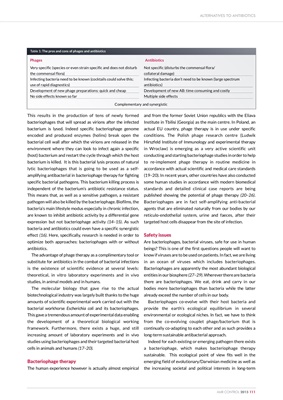
This results in the production of tens of newly formed
bacteriophages that will spread as virions after the infected
bacterium is lysed. Indeed specific bacteriophage genome
encoded and produced enzymes (holins) break open the
bacterial cell wall after which the virions are released in the
environment where they can look to infect again a specific
(host) bacterium and restart the cycle through which the host
bacterium is killed. It is this bacterial lysis process of natural
lytic bacteriophages that is going to be used as a selfamplifying
antibacterial in bacteriophage therapy for fighting
specific bacterial pathogens. This bacterium killing process is
independent of the bacterium's antibiotic resistance status.
This means that, as well as a sensitive pathogen, a resistant
pathogen will also be killed by the bacteriophage. Biofilms, the
bacteria's main lifestyle modus especially in chronic infection,
are known to inhibit antibiotic activity by a differential gene
expression but not bacteriophage activity (14-15). As such
bacteria and antibiotics could even have a specific synergistic
effect (16). Here, specifically, research is needed in order to
optimize both approaches: bacteriophages with or without
antibiotics.
The advantage of phage therapy as a complimentary tool or
substitute for antibiotics in the combat of bacterial infections
is the existence of scientific evidence at several levels:
theoretical, in vitro laboratory experiments and in vivo
studies, in animal models and in humans.
The molecular biology that gave rise to the actual
biotechnological industry was largely built thanks to the huge
amounts of scientific experimental work carried out with the
bacterial workhorse Escherichia coli and its bacteriophages.
This gave a tremendous amount of experimental data enabling
the development of a theoretical biological working
framework. Furthermore, there exists a huge, and still
increasing amount of laboratory experiments and in vivo
studies using bacteriophages and their targeted bacterial host
cells in animals and humans (17-20).
Bacteriophage therapy
The human experience however is actually almost empirical
and from the former Soviet Union republics with the Eliava
Institute in Tbilisi (Georgia) as the main centre. In Poland, an
actual EU country, phage therapy is in use under specific
conditions. The Polish phage research centre (Ludwik
Hirszfeld Institute of Immunology and experimental therapy
in Wroclaw) is emerging as a very active scientific unit
conducting and starting bacteriophage studies in order to help
to re-implement phage therapy in routine medicine in
accordance with actual scientific and medical care standards
(19-20). In recent years, other countries have also conducted
some human studies in accordance with modern biomedical
standards and detailed clinical case reports are being
published showing the potential of phage therapy (20-26).
Bacteriophages are in fact self-amplifying anti-bacterial
agents that are eliminated naturally from our bodies by our
reticulo-endothelial system, urine and faeces, after their
targeted host cells disappear from the site of infection.
Safety issues
Are bacteriophages, bacterial viruses, safe for use in human
beings? This is one of the first questions people will want to
know if viruses are to be used on patients. In fact, we are living
in an ocean of viruses which includes bacteriophages.
Bacteriophages are apparently the most abundant biological
entities in our biosphere (27-29). Wherever there are bacteria
there are bacteriophages. We eat, drink and carry in our
bodies more bacteriophages than bacteria while the latter
already exceed the number of cells in our body.
Bacteriophages co-evolve with their host bacteria and
provide the earth's ecological equilibrium in several
environmental or ecological niches. In fact, we have to think
from the co-evolving couplet phage/bacterium that is
continually co-adapting to each other and as such provides a
long-term sustainable antibacterial approach.
Indeed for each existing or emerging pathogen there exists
a bacteriophage, which makes bacteriophage therapy
sustainable. This ecological point of view fits well in the
emerging field of evolutionary/Darwinian medicine as well as
the increasing societal and political interests in long-term
ALTERNATIVES TO ANTIBIOTICS
AMR CONTROL 2015 111
Table 1: The pros and cons of phages and antibiotics
Very specific (species or even strain specific and does not disturb
the commensal flora)
Infecting bacteria need to be known (cocktails could solve this;
use of rapid diagnostics)
Development of new phage preparations: quick and cheap
No side effects known so far
Not specific (disturbs the commensal flora/
collateral damage)
Infecting bacteria don't need to be known (large spectrum
antibiotics)
Development of new AB: time consuming and costly
Multiple side effects
Phages Antibiotics
Complementary and synergistic